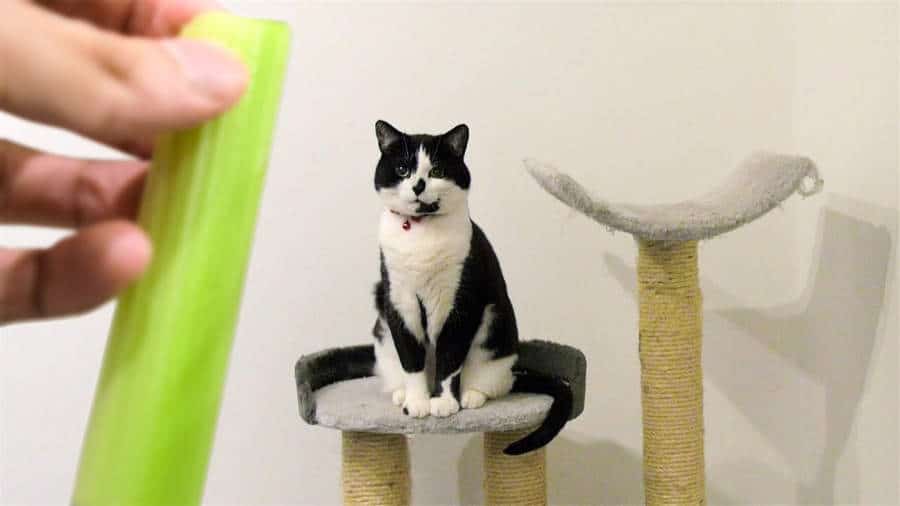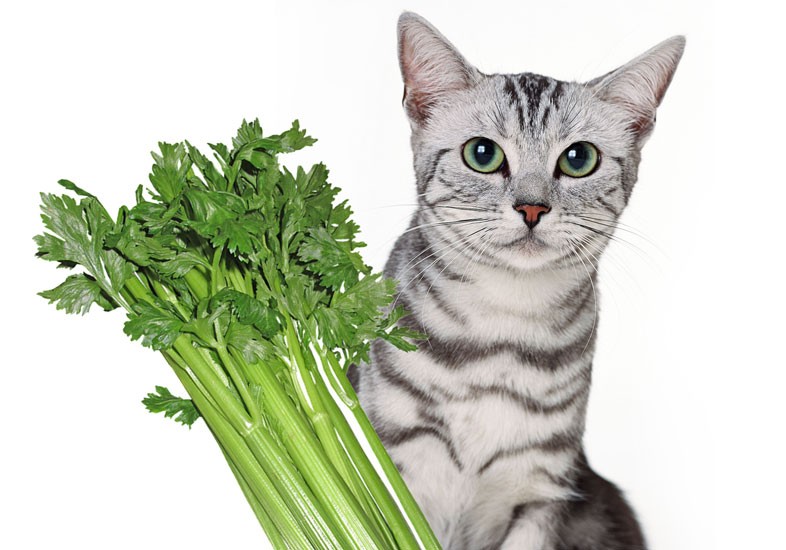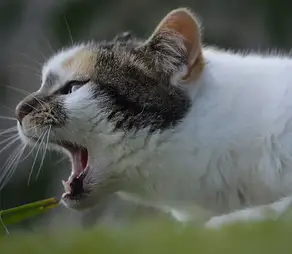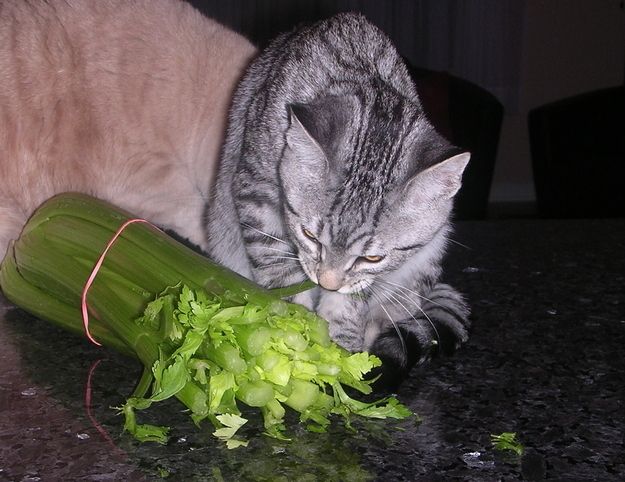For a vegetable, lover celery is very popular and one of the favorite food. Vegan people throughout the world love this vegetable and make delicious dishes that include celery. In India also there are many dishes related to this vegetable and people love to have this in their regular diet.
However, a person cannot think to serve celery to a cat. Generally, a cat’s diet is quite different than humans and does not include celery anyway. Therefore we have to be aware of serving celery to a cat. The digestion system of a cat is very different from a human thus we should be careful about feeding a cat such kind of food.
Benefits of Consuming Celery

It is already stated earlier that celery has some very healthy benefits and could be beneficial for humans as well as cats. Some of those benefits are mentioned briefly here.
Improves Digestive Health
A person who is suffering from digestive problems can get drastic benefits from celery. Celery improves gut health and bowel regularity as it contains a higher concentration of fiber. It enhances fullness and delays the return of hunger.
A person suffering from overweight problems must include this vegetable in their regular diet. People related to different sports used to have celery in their diet. One can put celery in different recipes such as salad, marinated veggies, and non-veg dishes. Celery adds a charismatic flavor to the soup and the use of celery in the soup is very popular.
Good Concentration of Antioxidants and Other Bioactive Compounds
This particular vegetable contains several types of antioxidants and a great number of anti-inflammatory substances. These kinds of components are used to prevent cellular damage. Hence it protects from premature aging as well as disease-related to cellular damage.
Other benefits include the optimization of blood circulation. Thus it is useful for patients suffering from high blood pressure problems.

Low Calory and Hydrating
Celery contains hydrating agents that help to keep your body hydrated. Body cells can remain hydrated which improves skin cells and other body cells. One large stalk of celery only supplies 7 calories.
Therefore you can include celery in your diet helps to maintain weight and delays your hunger. That keeps your body fit and hydrated and reduces body fat percentage and overweight problems. Many celebrities and sports persons include this vegetable as a mandatory item in their diet.
Provide Great Number of Key Nutrients

Just similar to other vegetables celery also provides vital vitamins and minerals. We can get vitamin A that supports immunity and improve skin and eye health. It also helps to improve lung strength.
Apart from vitamin A, it also provides up vitamin K that helps to cure blood clots and also protects from lower bone density.
This vegetable also supplies a smaller amount of Vitamin C and B, magnesium, calcium, and manganese. It helps to cure problems related to mental health like depression and also improves memory strength.
Helps to Reduce Inflammation
Normally older persons usually suffering from arthritis and osteoporosis. Chronic inflammation is the main reason behind these kinds of diseases. It affects bone density and several bone diseases can be observed as consequences.
Celery can be an essential treatment for such cases. As celery contains almost 25 anti-inflammatory compounds that offer protection against these kinds of diseases and fight against inflammation.
What We Need to Worry about a Cat Consuming Celery?

Normally Celery does not include typically in the diet of a cat. However, we can observe sometimes a cat eats vegetables such as celery. Specifically, they show interest in the celery leaves.
Kittens rub their faces on the celery leaves and often roll themselves. They attract towards celery leaves is almost similar to Catnip. It may be possible that celery leaves contain chemical compounds that attract cats.
Bacterial Infections Observed in Celery
There can be three types of bacterial disease that occur due to the consumption of celery. Two of them can be mostly observed. One is a bacterial leaf spot and another one is a bacterial blight. The third kind of disease can be rarely found known as bacterial soft rot.
Bacterial association with celery leaves generally occurs at the time of field production. In the case of bacterial blight, small water-soaked spots in leaf blades and develop a chlorotic halo. In the case of brown stem discoloration of petioles and brown streaks on petioles can be common symptoms.
Therefore you should be very cautious about feeding celery leaves to your cat. These kinds of bacteria are responsible for several bacterial infections in the cat’s body.
Fungal Disease Related to Celery

Few names of harmful diseases categorized as fungal diseases related to celery. Most popular names we can check out damping-off disease, downy mildew, Pink rot.
Symptoms related to damping-off are the rapid death of celery seeds in the premature state. In the case of downy mildew common symptoms that can be found are yellow spots on the surface of leaves. Lesions become darker as mature. For Pink rot symptoms can be seen are brown lesions on the base of the stalk with a pink margin, large black scars visible on infected tissues.
Hence we should check out these major symptoms before feeding celery to cats. Infected Celery is also harmful to human beings. Therefore you should cautious about these vegetable infections before consuming celery or before give it to your pet.
Disease Related to Celery Due to Pests
Some popular names of insects that affect celery and we should be cautious before feeding those. Aphids, Armyworms, and Nematodes generally attack celery plants.
The infestation of aphids causes yellow distorted leaves, necrotic spots on leaves. Armyworm feeds their young larvae and keeps them in celery plants. Dry and shallow wounds can be seen on the fruits and yellow and pink bodies of leaves also visible.
Due to the effect of nematodes plant roots become smaller and reduce plant vigor. Hence we need to be careful before consuming celery. And we should be very much concerned before giving it to cats or any other pet.
Spreading of Diseases By Different Means

Several ways are present through which the above-mentioned diseases can spread. Some brief descriptions are given below.
- If the spacing between plants is less then it encourages bacterial spreading. Temperature is another main factor for bacterial build-up. Normally in a region where the temperature is above 30°C is favorable for the growth of bacteria.
- For fungal infections ph level of the soil is a very important factor. Ph level close to 7 is a favorable condition for fungal growths. This kind of infection is introduced by infected plants or contaminated equipment used in cultivation.
The fungus can survive in the body of celery plants for up to 2 years and spreads during heavy rainfall. Air circulation is also responsible for spreading fungus from one plant to another. Hence contamination of water and soil are the adverse consequences.
- Insects normally attack celery plants during laying eggs. They collect substances from the plant and affect the plant in a very harmful way. Cats consume such plants may be affected by intaking larvae.
Precautions We Should Follow Before Proving Celery to Cats

As mentioned earlier celery is a very healthy routine for humans as well as cats. But we have found many diseases related to celery plants and how it spreads. Therefore we have to take some precautions as mentioned here.
- As we already know cats love to have celery leaves, we should care about cleanliness before give them to them. You need to wash it with fresh water or better to use hot water and then give it to your cat.
- We have to be careful about bacterial infection or any other kind of infection of the plant. You should eliminate such kinds of plants when identified as infected.
- If a cat consumes too much celery that will induce diarrhea. Diarrhea can cause very harmful results, even death threats. If you find out your cat suffering from this disease then you should take your cat to the nearby pet clinic.
- You should be careful about the limit of consumption of celery by your cat. Because celery is not included in a typical cat diet. And digestion system of a cat is very different from a human. Hence we should be careful about it.
Celery is one of the popular among vegetables as it supplies several good elements. It is a good supplier of vitamins and minerals. This vegetable is very helpful for weight management as we already mentioned. It is also helpful to keep your cat’s body hydrated.
But we have to be careful about the diseases related to it. And the amount of consumption of it by your cat, as we know the body functions of a cat is very different for a human. However, the cat loves celery leaves and there is no problem to include it in your cat’s diet. You just need to follow some basic precautions and maintain hygiene to avoid adverse effects.
